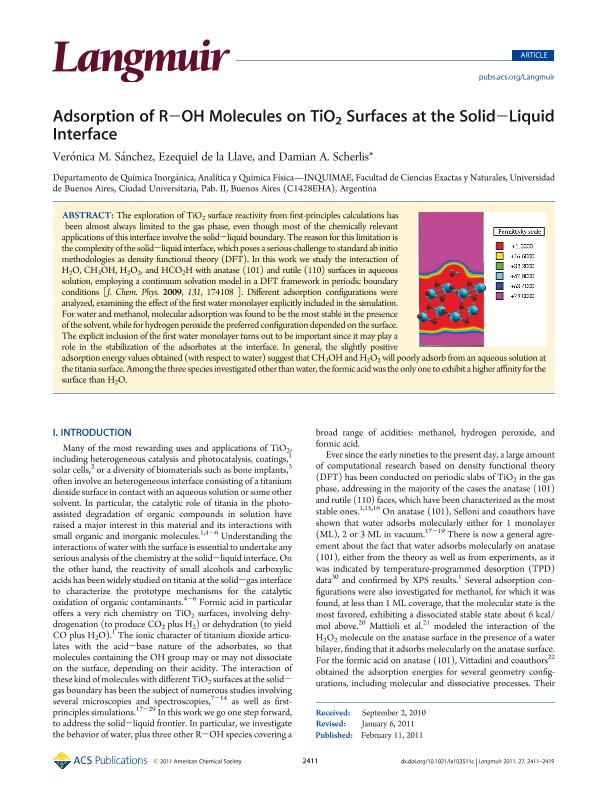Mostrar el registro sencillo del ítem
dc.contributor.author
Sanchez, Veronica Muriel

dc.contributor.author
de la Llave, Ezequiel Pablo

dc.contributor.author
Scherlis Perel, Damian Ariel

dc.date.available
2019-03-19T16:08:10Z
dc.date.issued
2011-03
dc.identifier.citation
Sanchez, Veronica Muriel; de la Llave, Ezequiel Pablo; Scherlis Perel, Damian Ariel; Adsorption of R-OH molecules on TiO2 surfaces at the solid-liquid interface; American Chemical Society; Langmuir; 27; 6; 3-2011; 2411-2419
dc.identifier.issn
0743-7463
dc.identifier.uri
http://hdl.handle.net/11336/72005
dc.description.abstract
The exploration of TiO2 surface reactivity from first-principles calculations has been almost always limited to the gas phase, even though most of the chemically relevant applications of this interface involve the solid-liquid boundary. The reason for this limitation is the complexity of the solid-liquid interface, which poses a serious challenge to standard ab initio methodologies as density functional theory (DFT). In this work we study the interaction of H2O, CH3OH, H2O2, and HCO2H with anatase (101) and rutile (110) surfaces in aqueous solution, employing a continuum solvation model in a DFT framework in periodic boundary conditions [J. Chem. Phys. 2009, 131, 174108 ]. Different adsorption configurations were analyzed, examining the effect of the first water monolayer explicitly included in the simulation. For water and methanol, molecular adsorption was found to be the most stable in the presence of the solvent, while for hydrogen peroxide the preferred configuration depended on the surface. The explicit inclusion of the first water monolayer turns out to be important since it may play a role in the stabilization of the adsorbates at the interface. In general, the slightly positive adsorption energy values obtained (with respect to water) suggest that CH3OH and H2O2 will poorly adsorb from an aqueous solution at the titania surface. Among the three species investigated other than water, the formic acid was the only one to exhibit a higher affinity for the surface than H2O. © 2011 American Chemical Society.
dc.format
application/pdf
dc.language.iso
eng
dc.publisher
American Chemical Society

dc.rights
info:eu-repo/semantics/openAccess
dc.rights.uri
https://creativecommons.org/licenses/by-nc-sa/2.5/ar/
dc.subject
Ccontinuum Solvent Model
dc.subject
Dft
dc.subject
Rutile
dc.subject
Anatase
dc.subject.classification
Otras Ciencias Químicas

dc.subject.classification
Ciencias Químicas

dc.subject.classification
CIENCIAS NATURALES Y EXACTAS

dc.title
Adsorption of R-OH molecules on TiO2 surfaces at the solid-liquid interface
dc.type
info:eu-repo/semantics/article
dc.type
info:ar-repo/semantics/artículo
dc.type
info:eu-repo/semantics/publishedVersion
dc.date.updated
2019-03-08T20:17:04Z
dc.journal.volume
27
dc.journal.number
6
dc.journal.pagination
2411-2419
dc.journal.pais
Estados Unidos

dc.journal.ciudad
Washington
dc.description.fil
Fil: Sanchez, Veronica Muriel. Consejo Nacional de Investigaciones Científicas y Técnicas. Oficina de Coordinación Administrativa Ciudad Universitaria. Instituto de Química, Física de los Materiales, Medioambiente y Energía. Universidad de Buenos Aires. Facultad de Ciencias Exactas y Naturales. Instituto de Química, Física de los Materiales, Medioambiente y Energía; Argentina. Universidad de Buenos Aires. Facultad de Ciencias Exactas y Naturales. Departamento de Química Inorgánica, Analítica y Química Física; Argentina
dc.description.fil
Fil: de la Llave, Ezequiel Pablo. Consejo Nacional de Investigaciones Científicas y Técnicas. Oficina de Coordinación Administrativa Ciudad Universitaria. Instituto de Química, Física de los Materiales, Medioambiente y Energía. Universidad de Buenos Aires. Facultad de Ciencias Exactas y Naturales. Instituto de Química, Física de los Materiales, Medioambiente y Energía; Argentina. Universidad de Buenos Aires. Facultad de Ciencias Exactas y Naturales. Departamento de Química Inorgánica, Analítica y Química Física; Argentina
dc.description.fil
Fil: Scherlis Perel, Damian Ariel. Consejo Nacional de Investigaciones Científicas y Técnicas. Oficina de Coordinación Administrativa Ciudad Universitaria. Instituto de Química, Física de los Materiales, Medioambiente y Energía. Universidad de Buenos Aires. Facultad de Ciencias Exactas y Naturales. Instituto de Química, Física de los Materiales, Medioambiente y Energía; Argentina. Universidad de Buenos Aires. Facultad de Ciencias Exactas y Naturales. Departamento de Química Inorgánica, Analítica y Química Física; Argentina
dc.journal.title
Langmuir

dc.relation.alternativeid
info:eu-repo/semantics/altIdentifier/doi/https://dx.doi.org/10.1021/la103511c
dc.relation.alternativeid
info:eu-repo/semantics/altIdentifier/url/https://pubs.acs.org/doi/10.1021/la103511c
Archivos asociados
